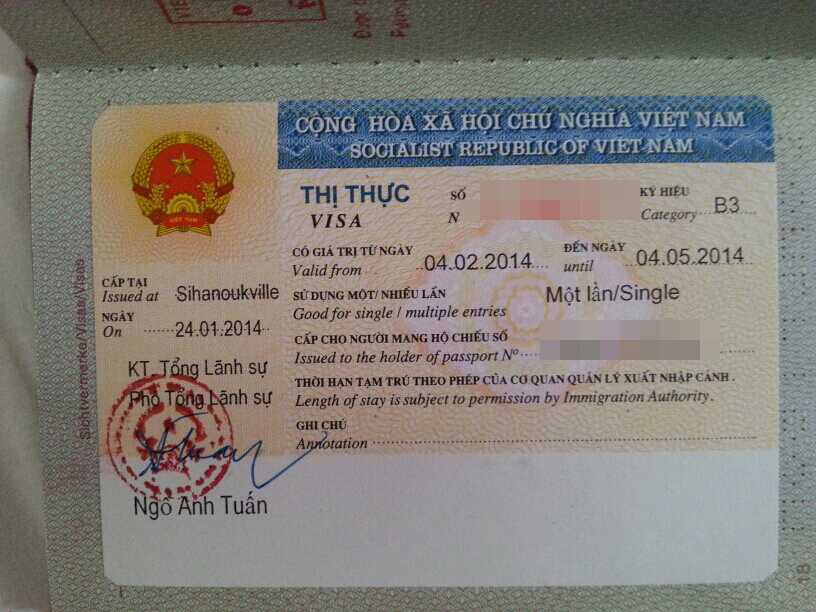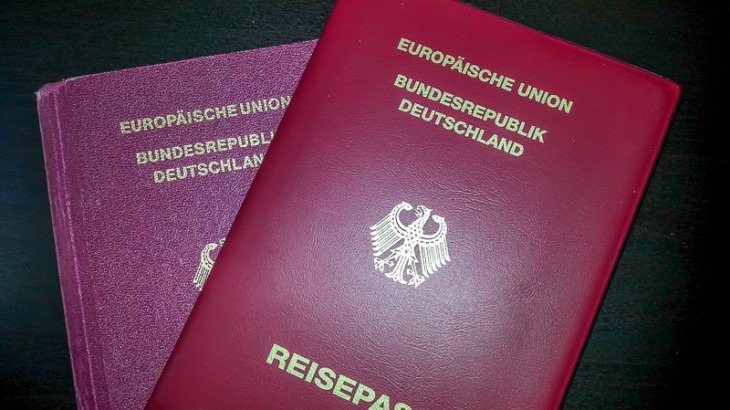In 2014 I wrote an article on how to get a visa for Vietnam at the Vietnamese Embassy in Sihanoukville. The Vietnam visa situation continues to confuse many people, and after the new changes on visas on arrival in late 2015, I’ve received a lot of questions about who needs a visa, how to get one and how to pay for it. So here’s a quick Vietnam Visa 2016 update with everything you need to know about a Vietnam visa for your next holiday.
Note: This is based on my own info and research. Visa policies change quickly, so please use this a guide, but check with your local embassy that this information is still valid. I can give no guarantee on the information below, I’m simply sharing my own experience as someone who has traveled to Vietnam quite a bit.
Who needs a visa for Vietnam?
In general, anyone traveling to Vietnam for vacation or business needs a visa. There is a new recent exemption for travelers holding a passport from some EU and ASEAN countries, provided they stay in Vietnam for 15 days or less (see below). If your passport is not from one of the exempt countries, or you are planning to stay longer than 15 days, you must arrange a visa before you get to Vietnam.
In that case, you have two options: A visa issued by a Vietnamese embassy near you, or a prearranged visa on arrival.
Vietnam visa on arrival vs. Vietnam visa issued by embassy
The principal difference is this: If you choose to get your visa from an embassy, you must send in your passport or deliver it in person to a Vietnamese embassy near you, so in most cases, you will be without a passport for at least a day or two, depending on how fast your local embassy works. The fees are usually also higher than a visa on arrival. However, you will have an official Vietnam visa in your passport before your departure, and you can be 100% sure that the visa is genuine.
If you choose a visa on arrival instead, you simply send an application form to a visa agency, pay a processing fee and they will provide you with a visa letter to present at the airport upon arrival in Vietnam. You do not need to hand in your passport, it can be done conveniently from home or any computer on the road if you’re traveling, and the fees tend to be cheaper than for the embassy visa option. But you must always arrange the visa in advance, there is no instant visa on arrival as you may know it from other countries like Laos or Cambodia.
There is one important caveat: The visa on arrival is only an option if you are traveling to Vietnam by air. You will NOT be able to enter the country with a visa on arrival at a land border crossing!
Getting an embassy issued visa
If you choose to get your visa from an embassy, allow for some time for processing, especially before Vietnamese New Year (the date changes every year, but is typically in January or February). Your local embassy’s website is the best resource for information on visa processing times and fees.
If you are traveling to Vietnam overland and passing through countries like Laos, Cambodia or Thailand beforehand, check out the visa options at the local embassies there. You can generally get a Vietnam visa from any embassy worldwide, regardless of your nationality, and local embassies in South East Asia tend to have cheaper fees and faster processing times than embassies in Europe or North America, for example. Check out my post on getting a visa for Vietnam in Sihanoukville, Cambodia – one of the cheapest options out there.
You’ll also find that many travel agencies in those countries offer to process your visa for you. You can leave your passport with them, and they will go to the embassy to process it for you. This option saves you time, but you loose the guarantee of getting an authentic visa, you’re trusting a stranger with your passport, so choose wisely and ask other travelers for recommendations.

A real visa, issued directly by the Vietnamese embassy in Sihanoukville
Getting a prearranged visa on arrival
I may sound like a broken record, but make sure you arrange this in advance. If you show up at the airport without a visa letter, you’re out of luck and may be denied entry.
There are plenty of agencies out there that offer visa on arrival processing. If you are going on an organized tour, your tour provider will likely also offer this, as will your hotel in the first city you’re staying in. We chose to get our visa letter arranged by our hotel in Saigon. We had stayed with them before and trusted them, so we felt this was the best option. A quick Google search will find you plenty of agency options though, and there are few reports about scams. Just make sure to pick one with some good reviews and you should be okay.
The process then is the following: You fill in an application form with your passport details and details of your trip, choosing the length of your stay and your date of entry. You send in this form along with a copy of your passport and a scanned passport photo. Within 2-4 business days, you’ll get your visa letter, which will give you permission to pick up a visa on arrival with your chosen length of stay on your chosen date of entry (you can also enter a few days after that, but NOT before – so pick an earlier date if your flights have not been booked yet).
I feel it’s important to mention that these letters are usually group letters that your visa agencies submits in bulk, and will list all names, birth dates and passport numbers of those who have arranged a visa through that agency that day, so your passport number will be seen by strangers. If this is an issue for you, search for an agency offering “Private visa on arrival” to receive a letter that only lists your travel party’s information.
Process upon arrival at a Vietnamese airport
Prepare the following for your visa and make sure to pack it in your hand luggage:
- Your printed, prearranged visa letter
- A printed and filled out entry form: Your visa agency will usually provide this, but you can also pick up a copy at the airport if needed
- Your stamping fee in cash: As of 2016, it’s USD25 for a single entry visa and USD50 for a multiple entry visa, regardless of duration of the visa
- Two passport photos. I’ve only ever needed one in reality, but every agency states two, so if you have two, bring them both, just in case.
- Your passport. Make sure it’s valid for at least 6 more months.
Go to the visa on arrival counter, hand in all your documents with your passport, sit in the waiting area until your name is called. Once you’re called up, pay your stamping fee and pick up your passport. It’s an easy process, but may take a bit of time if there are a lot of flights coming in. It took us about 25 minutes to get our passports with the printed full page visas back. When you have your passport, just head to immigration, get your entry stamp, and you’re in Vietnam! The hardest part about this whole process is understanding your name when it’s called up with a Vietnamese accent.
Using the visa exemption option
If you hold a passport from one of the following countries, you can currently enter Vietnam without a visa if you are staying for 15 days or less. Your passport must be valid for 6 more months, and you should bring a printed copy of your return flight ticket with you.
Passports valid for a visa exemption: Belarus, Brunei, Cambodia, Denmark, Finland, France, Germany, Indonesia, Italy, Japan, Kyrgyzstan, Laos, Malaysia, Myanmar, Norway, Philippines, Russia, Singapore, South Korea, Spain, Sweden, Thailand, United Kingdom.
Note: Most ASEAN passport holders even get a 30 day visa exemption. As always, check with your local embassy for exact and up to date information.
The visa exemption policy changes regularly, and the exemption for the UK, France, Germany, Italy and Spain was only recently added in the summer of 2015, and will officially run out in June of 2016. It’s very likely that it will be renewed, but you should check with your local embassy beforehand and be prepared to arrange a visa at short notice if necessary for trips after June 2016. I also recommend that you print out a copy of the visa exemption rules for your country ideally from your country’s Vietnam embassy, to show to your airline if needed. Especially if you are flying in from a third country, your airline may not be aware of the visa exemption and may deny you boarding if not sufficiently convinced that you can get a visa exemption. This has happened to me in the past traveling from Jamaica to the United States, for example – I had to put up quite a bit of a fight to be allowed to board the plane, as they were convinced I wouldn’t be allowed to enter without a visa!
Which visa option do you recommend?
As always: it depends. If you’re going for a short trip and you know exactly when you’re entering or leaving, take advantage of the Vietnam visa exemption if it applies to your nationality. If you don’t know yet how long you’ll be staying exactly, or want more time to explore the country, the prearranged visa on arrival is a quick and cheap option. Since the stamping fee is now the same for a one month and a three month visa, consider getting a three month visa if you are traveling on a flexible schedule. Vietnam is a beautiful country and you may end up wanting more time there than you think. Getting a visa from an embassy would be my last option, and I would only use it if entering the country overland, where the visa on arrival is not an option.
Where can I get more info?
The embassy responsible for your country of nationality is your single best option for reliable and definitive information, as Vietnam visa policies change often and quickly. They will, however, usually recommend their visa option, so if you are looking for advice and information on visa on arrival, asking other travelers is a good option, for example on the TripAdvisor Vietnam forums.
Enjoy your trip to Vietnam! Check out the following resources for some trip inspiration:


 English
English Deutsch
Deutsch